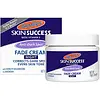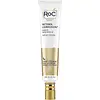What's inside
What's inside
 Key Ingredients
Key Ingredients

 Benefits
Benefits

 Concerns
Concerns

 Ingredients Side-by-side
Ingredients Side-by-side

Water
Skin ConditioningGlyceryl Stearate
EmollientParaffinum Liquidum
EmollientStearyl Stearate
EmollientNiacinamide
SmoothingPropylene Glycol
HumectantCetearyl Alcohol
EmollientPEG-100 Stearate
Ceteareth-20
CleansingPEG-75 Lanolin
EmollientDimethicone
EmollientIsopropyl Myristate
EmollientRetinol
Skin ConditioningTricholoma Matsutake Extract
Skin ConditioningTocopheryl Acetate
AntioxidantLavandula Angustifolia Oil
MaskingLeuconostoc/Radish Root Ferment Filtrate
AntimicrobialAscorbyl Glucoside
AntioxidantButylene Glycol
HumectantXanthan Gum
EmulsifyingDisodium EDTA
Magnesium Aluminum Silicate
AbsorbentCaprylic/Capric Triglyceride
MaskingSodium Sulfite
PreservativeSodium Metabisulfite
AntioxidantCitric Acid
BufferingBHT
AntioxidantPhenoxyethanol
PreservativeEthylhexylglycerin
Skin ConditioningSodium Lauryl Sulfate
CleansingSodium Sulfate
Linalool
PerfumingLimonene
PerfumingWater, Glyceryl Stearate, Paraffinum Liquidum, Stearyl Stearate, Niacinamide, Propylene Glycol, Cetearyl Alcohol, PEG-100 Stearate, Ceteareth-20, PEG-75 Lanolin, Dimethicone, Isopropyl Myristate, Retinol, Tricholoma Matsutake Extract, Tocopheryl Acetate, Lavandula Angustifolia Oil, Leuconostoc/Radish Root Ferment Filtrate, Ascorbyl Glucoside, Butylene Glycol, Xanthan Gum, Disodium EDTA, Magnesium Aluminum Silicate, Caprylic/Capric Triglyceride, Sodium Sulfite, Sodium Metabisulfite, Citric Acid, BHT, Phenoxyethanol, Ethylhexylglycerin, Sodium Lauryl Sulfate, Sodium Sulfate, Linalool, Limonene
Water
Skin ConditioningDimethicone
EmollientGlycerin
HumectantEthylhexyl Hydroxystearate
EmollientIsodecyl Neopentanoate
EmollientTetrahydroxypropyl Ethylenediamine
Stearyl Alcohol
EmollientCetearyl Alcohol
EmollientGlyceryl Stearate
EmollientPEG-100 Stearate
Ceteareth-20
CleansingSteareth-10
EmulsifyingMethyl Methacrylate Crosspolymer
Phenoxyethanol
PreservativeHydroxyethyl Acrylate/Sodium Acryloyldimethyl Taurate Copolymer
Emulsion StabilisingCaprylyl Glycol
EmollientAluminum Starch Octenylsuccinate
AbsorbentGlycolic Acid
BufferingSqualane
EmollientParfum
MaskingButyrospermum Parkii Butter
Skin ConditioningMethylparaben
PreservativeCitric Acid
BufferingXanthan Gum
EmulsifyingPropylparaben
PreservativeRetinol
Skin ConditioningPolysorbate 20
EmulsifyingBHT
AntioxidantDisodium EDTA
Polysorbate 60
EmulsifyingAscorbic Acid
AntioxidantMagnesium Aspartate
Skin ConditioningZinc Gluconate
Skin ConditioningSorbitan Isostearate
EmulsifyingCopper Gluconate
Skin ConditioningWater, Dimethicone, Glycerin, Ethylhexyl Hydroxystearate, Isodecyl Neopentanoate, Tetrahydroxypropyl Ethylenediamine, Stearyl Alcohol, Cetearyl Alcohol, Glyceryl Stearate, PEG-100 Stearate, Ceteareth-20, Steareth-10, Methyl Methacrylate Crosspolymer, Phenoxyethanol, Hydroxyethyl Acrylate/Sodium Acryloyldimethyl Taurate Copolymer, Caprylyl Glycol, Aluminum Starch Octenylsuccinate, Glycolic Acid, Squalane, Parfum, Butyrospermum Parkii Butter, Methylparaben, Citric Acid, Xanthan Gum, Propylparaben, Retinol, Polysorbate 20, BHT, Disodium EDTA, Polysorbate 60, Ascorbic Acid, Magnesium Aspartate, Zinc Gluconate, Sorbitan Isostearate, Copper Gluconate
Ingredients Explained
These ingredients are found in both products.
Ingredients higher up in an ingredient list are typically present in a larger amount.
BHT is a synthetic antioxidant and preservative.
As an antioxidant, it helps your body fight off free-radicals. Free-radicals are molecules that may damage your skin cells.
As a preservative, it is used to stabilize products and prevent them from degrading. Specifically, BHT prevents degradation from oxidation.
The concerns related to BHT come from oral studies; this ingredient is currently allowed for use by both the FDA and EU.
However, it was recently restricted for use in the UK as of April 2024.
Learn more about BHTCeteareth-20 is an emulsifier and cleansing agent. It is derived from cetearyl alcohol, a fatty alcohol.
As an emulsifier, Ceteareth-20 prevents oil and water from separating. It is also a surfactant. Surfactants help gather oil, pollution, and dirt to be washed away.
Cetearyl alcohol is a mixture of two fatty alcohols: cetyl alcohol and stearyl alcohol. It is mainly used as an emulsifier. Emulsifiers help prevent the separation of oils and products. Due to its composition, it can also be used to thicken a product or help create foam.
Cetearyl alcohol is an emollient. Emollients help soothe and hydrate the skin by trapping moisture.
Studies show Cetearyl alcohol is non-toxic and non-irritating. The FDA allows products labeled "alcohol-free" to have fatty alcohols.
This ingredient is usually derived from plant oils such as palm, vegetable, or coconut oils. There is debate on whether this ingredient will cause acne.
Due to the fatty acid base, this ingredient may not be Malassezia folliculitis safe.
Learn more about Cetearyl AlcoholCitric Acid is an alpha hydroxy acid (AHA) naturally found in citrus fruits like oranges, lemons, and limes.
Like other AHAs, citric acid can exfoliate skin by breaking down the bonds that hold dead skin cells together. This helps reveal smoother and brighter skin underneath.
However, this exfoliating effect only happens at high concentrations (20%) which can be hard to find in cosmetic products.
Due to this, citric acid is usually included in small amounts as a pH adjuster. This helps keep products slightly more acidic and compatible with skin's natural pH.
In skincare formulas, citric acid can:
While it can provide some skin benefits, research shows lactic acid and glycolic acid are generally more effective and less irritating exfoliants.
Most citric acid used in skincare today is made by fermenting sugars (usually from molasses). This synthetic version is identical to the natural citrus form but easier to stabilize and use in formulations.
Read more about some other popular AHA's here:
Learn more about Citric AcidDimethicone is a type of synthetic silicone created from natural materials such as quartz.
What it does:
Dimethicone comes in different viscosities:
Depending on the viscosity, dimethicone has different properties.
Ingredients lists don't always show which type is used, so we recommend reaching out to the brand if you have questions about the viscosity.
This ingredient is unlikely to cause irritation because it does not get absorbed into skin. However, people with silicone allergies should be careful about using this ingredient.
Note: Dimethicone may contribute to pilling. This is because it is not oil or water soluble, so pilling may occur when layered with products. When mixed with heavy oils in a formula, the outcome is also quite greasy.
Learn more about DimethiconeDisodium EDTA plays a role in making products more stable by aiding other preservatives.
It is a chelating agent, meaning it neutralizes metal ions that may be found in a product.
Disodium EDTA is a salt of edetic acid and is found to be safe in cosmetic ingredients.
Learn more about Disodium EDTAGlyceryl Stearate is a mix of glycerin and stearic acid.
It is used to stabilize the mixing of water and oil ingredients. By preventing these ingredients from separating, it can help elongate shelf life. It can also help thicken the product's texture.
As an emollient, it helps soften skin and supports barrier-replenishing ingredients.
In cosmetics, Glyceryl Stearate is often made from vegetable oils or synthetically produced.
This ingredient may not be fungal-acne safe
Fun fact: The human body also creates Glyceryl Stearate naturally.
Learn more about Glyceryl StearatePeg-100 Stearate is an emollient and emulsifier. As an emollient, it helps keep skin soft by trapping moisture in. On the other hand, emulsifiers help prevent oil and water from separating in a product.
PEGS are a hydrophilic polyether compound . There are 100 ethylene oxide monomers in Peg-100 Stearate. Peg-100 Stearate is polyethylene glycol ester of stearic acid.
Phenoxyethanol is a preservative that has germicide, antimicrobial, and aromatic properties. Studies show that phenoxyethanol can prevent microbial growth. By itself, it has a scent that is similar to that of a rose.
It's often used in formulations along with Caprylyl Glycol to preserve the shelf life of products.
Retinol is a gold-standard ingredient for anti-aging. It is a form of Vitamin A and belongs to the class of retinoids that also includes tretinoin.
Why is retinol famous?
It has the most scientific studies backing up its skin benefits out of all the non-prescription ingredients.
Retinol is proven to:
This is why retinol is effective at removing wrinkles, fading dark spots, treating acne, and reducing the appearance of pores.
Studies show retinol is less effective when exposed to UV. Be sure to look for appropriate packaging to keep your retinol potent (similar to Vitamin C).
Using retinol or any retinoids will increase sun-sensitivity in the first few months. Though studies show retinoids increase your skin's natural SPF with continuous use, it is best to always wear sunscreen and sun-protection.
We recommend speaking with a medical professional about using this ingredient during pregnancy.
Retinol may cause irritation in some people, so be sure to patch test. Experts recommend 'ramping up' retinol use: start using this ingredient once a week and work up to using it daily.
Read about Tretinoin
Learn more about RetinolWater. It's the most common cosmetic ingredient of all. You'll usually see it at the top of ingredient lists, meaning that it makes up the largest part of the product.
So why is it so popular? Water most often acts as a solvent - this means that it helps dissolve other ingredients into the formulation.
You'll also recognize water as that liquid we all need to stay alive. If you see this, drink a glass of water. Stay hydrated!
Learn more about WaterXanthan gum is used as a stabilizer and thickener within cosmetic products. It helps give products a sticky, thick feeling - preventing them from being too runny.
On the technical side of things, xanthan gum is a polysaccharide - a combination consisting of multiple sugar molecules bonded together.
Xanthan gum is a pretty common and great ingredient. It is a natural, non-toxic, non-irritating ingredient that is also commonly used in food products.
Learn more about Xanthan Gum